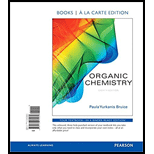
(a)
Interpretation:
The intermediate (A) formed by the reactants has to be identified. The mechanism for the formation of intermediate has to be shown.
Concept introduction:
Base abstracts an acidic proton to form a negatively charged species. The negative charged species is called nucleophile. The carbon which is attached to the electronegative atom is called the electrophilic carbon.
In the

(b)
Interpretation:
The mechanism for the conversion of A to B has to be shown. The compound which formed more rapidly has to be identified.
Concept introduction:
The reaction which takes place between two or more than two atoms which are present in the same molecule are called the intramolecular reactions.
Want to see the full answer?
Check out a sample textbook solution
Chapter 15 Solutions
ORGANIC CHEMISTRY (LL)-W/MOD.MASTERING.
- In the box to the left of each reaction below, write the mechanism by which it occurs (could be SN1, SN2, or E1, or even 2 of them). Then draw the product(s).arrow_forwardWhat is the product of the illustrated mechanism? A B C Darrow_forwardAlkyl diazonium salts decompose to form carbocations, which go on to form products of substitution, elimination, and (sometimes) rearrangement. Keeping this in mind, draw a stepwise mechanism that forms all of the following products.arrow_forward
- Show the steps of the next reaction in detail. And explain why it's hard to go along with the dotted line.arrow_forwardDraw the major product and state wheter the reaction is SN2, E2, SN1, or E1arrow_forwardHow does each of the following changes affect the rate of an E2 reaction? (d, e, and f)arrow_forward
 Organic Chemistry: A Guided InquiryChemistryISBN:9780618974122Author:Andrei StraumanisPublisher:Cengage Learning
Organic Chemistry: A Guided InquiryChemistryISBN:9780618974122Author:Andrei StraumanisPublisher:Cengage Learning
